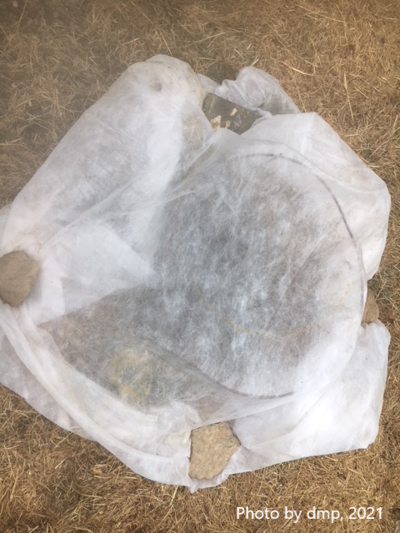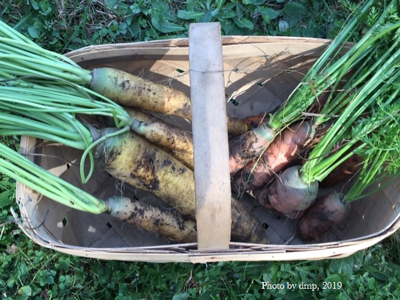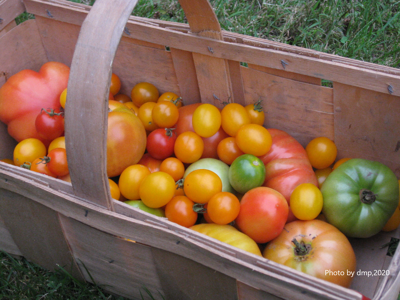Succession Planting
If looking to continuously supply the kitchen with a variety of interesting and healthy fresh vegetables, then succession planting is a technique to try. In its simplest form, succession planting is just growing the same or different crops one after another in the same spot. So, for instance, after quick-maturing radishes are harvested, one could plant bush beans, and after their harvest, a late summer crop of lettuce.
Another succession planting technique is to make several sowings of the same vegetable at regularly timed intervals. Typically, salad greens are planted this way because from a practical standpoint, it is not easy for a family to use up 30 heads of lettuce in a single week. It would make more sense to have smaller, more manageable harvests maturing every week or two. This method can also be used with pickling cucumbers. Many gardeners have difficulty controlling those bacterial wilt-carrying cucumber beetles so another hill of cucumber seeds can be planted every 3 weeks or so, keeping the newly germinated seedlings under a row cover until they start blossoming.

To make the most of space and increase yields, two or more crops can be planted simultaneously in the same bed. This works well with crops of different heights and maturation dates. Baby beets or early turnips can be planted in beds with Brussels sprouts; quick maturing lettuces or other salad greens with corn, or even at the base of trellised peas or beans. Early cabbage transplants can be slipped into winter squash beds.
Single plantings can be made of the same crop with different maturity dates. For instance, one can plant early, mid, and late season varieties of carrots, corn, potatoes or cabbages at one time for a longer, extended harvest.

Succession planting can be as easy or as intricate as one wants it to be. For more complex plans, it is important to become familiar with the cultural requirements and varietal characteristics of the vegetables or herbs to be grown. When coming up with a plan, first make a list of all the crops desired. Use gardening catalogs, books, websites and seed packages to find out important plant information like how early in spring the seeds or plants can go into the ground, the number of days from seed sowing or transplanting until harvest, space requirements, and the plant’s tolerance to frost.
Another consideration is how long the plants produce for. Are they plucked out of the ground, like carrots, providing an empty space to plant another seeding or transplants into? Will a secondary crop be produced after the main harvest? For instance, some species of broccoli will continue producing side shoots well into the fall. Kale and Swiss chard will continue to grow new leaves throughout the growing season so a long harvest is the norm.
Indeterminate types of tomatoes will continue producing after the determinate ones are spent. Another consideration when growing tomatoes is how they will be used – fresh, frozen, dried or canned. Determinate varieties stop growing once they set flowers while indeterminate ones continue to grow foliage and produce flowers until stopped by frost or disease. So the determinate varieties will produce fruit that ripen all at once and this is very useful if the harvest is to be canned or frozen.

One also needs to take into account about when the soil can be worked in the spring, the approximate dates of the last and first frosts of the season, and about when the soil freezes and the harvest season comes to an end. Despite its relatively small size, there can be a two week or more difference in seasonal variation between southern and northern Connecticut. Typically, last frost is anticipated around mid-May and the first frost can occur anytime after mid-September. Most of us experience a growing season of at least 120 days.
It is a good idea to compile this information into a planting chart or notebook. Then one can come up with initial planting dates, harvest times, and dates for planting successive crops. Leave room for notes as pests and weather conditions may alter even the most carefully made plans. Also, comments from previous growing seasons are useful both when deciding what to grow again and also deviations from stated days to harvest.
Vegetables can be divided into 5 categories for succession planning purposes. Short season, cool weather crops include radishes, cress, some lettuce and turnip varieties, arugula, spinach, and a host of baby greens. These vegetables prefer cooler weather and can usually be picked in 30 to 40 days after planting. One or two sowings can be made starting in April and again in late August or September. They are also able to withstand some frost but they will bolt (or go to seed) in hot weather so they are not well suited for summer sowings. For later spring and early summer plantings, select varieties that are labeled slow to bolt.
Cool season, intermediate crops mature in 50 to 80 days and consist of both those set in the garden as transplants like broccoli, cauliflower and cabbage, and direct seeded Swiss chard, kohlrabi, peas, carrots, collards and beets. Warm season, intermediate crops take a similar amount of time to mature but are not frost tolerant and thrive during the hot summer weather. They include summer squash, cucumbers and beans.
Long season crops are divided into those that can bear over several weeks or months like peppers and tomatoes, and those that produce a harvest at the end of their growth cycle such as corn, winter squash, sweet potatoes, Brussels sprouts, onions, and potatoes. Onions, Brussels sprouts, potatoes, and leeks can be set out in May and even earlier in some locations. Corn, squash, peppers and tomatoes are not generally planted until the threat of late frosts has passed.
Keep in mind that the dates to anticipated harvest assume that seeds are sown or transplants set in the ground at the recommended planting time. With succession planting, seeds and plants are added throughout the growing season. Weather conditions and the angle of the sun greatly affect the rate at which vegetables grow and mature.
During cooler springs, pea seeds planted two weeks apart may mature within a week of each other because plants grow faster as the weather warms and the days lengthen. The opposite is true at the end of summer with cooler weather and shorter days. Cabbages, which would typically mature in 50 or 60 days, may take 70 days to form a head as the number of hours of sunlight each day decreases. This is one reason why keeping records is important.
A few crops like radishes, carrots and spinach are always direct seeded into the garden but others like summer squash, cucumbers, lettuces, Chinese cabbages and kale can be either direct seeded or started in pots and transplanted into the garden. One may have noticed that a few local garden centers are selling young transplants in late summer for second plantings. One can also try starting a few seeds in early August for transplanting into the garden or sown directly into garden beds to fill any areas left bare from harvest or mishap.
Maintaining a fertile garden soil and supplying plants with adequate water is crucial for successful succession plantings especially if tighter spacings and double croppings are being used. Any plants or seeds being planted during the heat of the summer will require careful attention to watering.
Succession planting is a great way to make the most efficient use of garden space and, also to provide a delicious, varying menu of vegetables for the dinner table. It may open a whole new way of planning the home vegetable garden.
Despite good cultural practices, pests and diseases at times may appear. Chemical control should be used only after all other methods have failed. For pesticide information, please call the UConn Home & Garden Education Center, weekdays at (877) 486-6271.
UConn Home and Garden Education Center, D. Pettinelli, 2021
Issued in furtherance of Cooperative Extension work, Acts of May 8 and June 30, 1914, in cooperation with the U.S. Department of Agriculture, the Dean of the College, Cooperative Extension System, University of Connecticut, Storrs. The Connecticut Cooperative Extension System is an equal opportunity employer and program provider. To file a complaint of discrimination, write USDA, Director, Office of Civil Rights, Room 326-W, Whitten Building, Stop Code 9410, 1400 Independence Avenue, SW, Washington, DC 20250-9410 or call (202) 720-5964